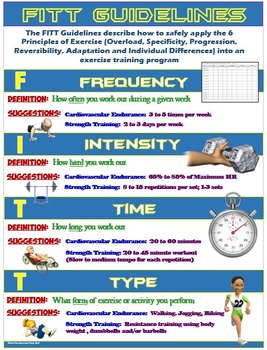The American College of Sports Medicine, founded in 1954, publishes physical activity guidelines for the public to take into consideration. ACSM's most recent strength-training guidelines were established in 2011. Their position statement provides basic guidelines and principles to help you establish a strength training program.
Exercise also improves the sensitivity of muscle cells to insulin. Since 80 percent of people with type 2 diabetes are overweight or obese, losing weight and fat through diet and exercise are important treatments for controlling blood sugar levels. They also decrease the risk of developing cardiovascular diseases and help prevent type 2 diabetes. The FITT Principle is the most basic rule of thumb used to guarantee your workout plan matches both your experience and your goals. So before you can put it into practice, you need to define both of those things. These rules relate to the Frequency, Intensity, Type and Time (FITT) of exercise. These four principles of fitness training are applicable to individuals exercising at low to moderate training levels and may be used to establish guidelines for both cardiorespiratory and resistance training.
Finding Your Frequency
ACSM recommends that healthy adults train two to three times per week. If you are an older adult or have been sedentary, start with two times per week and choose light intensity exercises. Spread your resistance training sessions out throughout the week. ACSM suggests a 48 hour break between sessions.
Deciding on Sets and Reps
ACSM recommends eight to 10 different exercises. Start by doing eight to 12 repetitions of each exercise to improve strength and power. To improve muscular endurance, increase to 10 to 15 repetitions. Select a weight that you reach fatigue within the given repetition range -- that's the point when you don't think you can lift one more repetition with proper form. When you can complete one to two repetitions more than the recommended range, increase the weight by 2 to 10 percent.

Choosing Exercises
Choose exercises that target all of the major muscle groups. Include compound and isolation exercises, but focus most of your training around compound exercises. Isolation exercises are single-joint movements that target only one muscle group. Triceps pressdowns and biceps curls are isolation exercises. Compound exercises are multijoint movements that work more than one muscle group. Squats, chest presses, overhead presses and deadlifts are compound exercises.
Fitt Exercise Guidelines For Weight Loss
Learning Technique
Fitt Exercise Guidelines For Men
Learn the proper technique for each exercise. Do not use momentum or jerky motions to move a weight. Start with light weights and increase the resistance over time as you become stronger. Do not hold your breath. Exhale during the exertion phase of the movement and inhale during the lowering phase. These are basic guidelines for those seeking general health and fitness benefits. If you are training for a specific goal, such as muscle growth or strength, you will need to adjust your program.